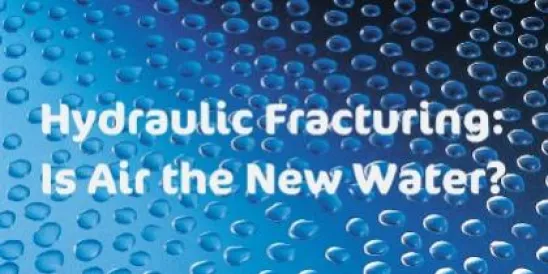Hydraulic fracturing, or fracing, continues to be closely scrutinized by the public and regulators alike for its potential impact on water resources, e.g., possible contamination of drinking water. However, recent events indicate air emissions are likely to become the next “big issue” in the fracing discussion.
Hydraulic fracturing, or fracing, continues to be closely scrutinized by the public and regulators alike for its potential impact on water resources, e.g., possible contamination of drinking water, volume of water used and disposal of used fracing wastewater. These water issues have dominated the debate for some time, overshadowing concerns that some have raised about potential impacts on air quality. Recent events, however, indicate air emissions are likely to become the next “big issue” in the fracing discussion.
On April 3, 2012, Henry Waxman (D-CA) and Diana DeGette (D-CO) wrote to U.S. Environmental Protection Agency (EPA) Administrator Lisa Jackson asking the agency to consider a recent Colorado School of Public Health study linking air emissions from hydraulic fracturing activities to increased risks of cancer and non-cancer illnesses. The letter came one day after EPA delayed publication of final rules for air emissions from oil and gas extraction activities. EPA says it delayed issuing final rules to give itself time to review the more than 156,000 public comments submitted on the draft rules.
The Colorado School of Public Health risk assessment follows two other recent studies about air quality issues and hydraulic fracturing. All three studies are briefly discussed below.
Colorado School of Public Health Study
The Colorado School of Public Health (CSPH) study found that residents of Battlement Mesa who reside within a half mile of a hydraulically fractured well have an increased risk of contracting illnesses because of volatile organic compounds (VOCs) released into the air by drilling operations. The study methodology and analysis have been criticized by stakeholder groups for using data gathered prior to enactment of stricter state air standards; for assuming that residents remain in town for 350 days per year, 24 hours per day, thus receiving 24-hour doses; and, most important, for disregarding VOC contributions from local highway traffic.
The air sampling results were taken from three years of Garfield County Public Health Department air monitoring data and analyzed "using EPA methodology." However, Garfield County health official Jim Rada reported air quality in Garfield County falls within EPA standards, and nothing so far suggests the Battlement Mesa population is at increased risk of cancer.
The study was commissioned by Garfield County in 2010 at the request of Battlement Mesa residents, then decommissioned by the county in May 2011 after questions were raised by the County Department of Public Health. CSPH scientists continued with the analysis on their own, and are scheduled to publish their results in an upcoming edition of Science of the Total Environment. Garfield County, however, disavows any connection to the study.
In an interesting twist to this story, Battlement Mesa residents are part of what is widely considered the test case for class actions alleging harm from fracing. The suit contends residents have suffered health impacts from air and water contamination as a result of gas development at a well pad near the community, and stand to endure further environmental effects and diminution of property value because of plans to drill up to 200 additional wells within town limits.
Pavilion, Wyoming, Air Monitoring Results
The Wyoming Department of Environmental Quality recently released the results of air monitoring in Pavilion conducted from Jan. 27, 2011, to Dec. 31, 2011. Pavilion first made headlines in late 2011 when EPA issued a draft report concluding that fracing in the area had contaminated shallow drinking water—the first time the agency had ever reached such a conclusion. None of the air samples taken in Pavilion tested above federal or state action levels, clearing energy extraction activities in the area of allegations of contributing to air pollution. The results, called "preliminary" by media outlets reporting on the story, have been criticized as skewed based on the placement of the monitoring stations and the effects of a mild winter and early spring. Once the data is finalized, it will be presented to the residents at a public meeting. The date of that meeting has not yet been set.
National Oceanographic and Atmospheric Administration Report on Fracking Emissions
A recent study by National Oceanographic and Atmospheric Administration (NOAA) scientists, reported in the Journal of Geophysical Research in February 2012, concluded that fugitive natural gas emissions from drilling operations ranged from 3 percent to 5 percent. These findings were roughly in line with an earlier Howarth (Cornell University) study, but came in above industry reported levels. Critics quickly pointed to the study as evidence that fracing is making significant contributions to greenhouse gas emissions, invoking the results as a basis for increased federal regulation in the area.
Conclusion
While water issues have long dominated the debate over hydraulic fracturing, air emissions are quickly taking on a prominent role in the discussion. EPA is finalizing its rules to address such emissions, and the three reports discussed above very well may effect the content of those rules. Those rules, coupled with the growing emphasis on air quality issues, may counsel stakeholders to consider baseline air quality and emissions testing prior to commencing any fracing operation.




 />i
/>i

